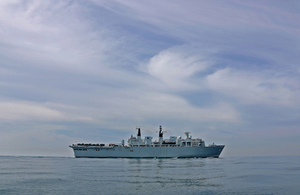Thousands of troops from UK-led force begin milestone maritime training deployment
Exercises got underway today across Scandinavia and the Baltic Sea region as a part of Baltic Protector.

HMS Albion, a British warship, sails alone on a quiet sea with a wide open sky in the background.
A total of 3,000 military personnel and 17 vessels from nine nations will contribute to the first major maritime training deployment of the UK-led Joint Expeditionary Force (JEF) in the coming weeks.
Minister for the Armed Forces Mark Lancaster said:
From Denmark to Lithuania, from Sweden to Estonia, Baltic Protector will leave potential adversaries in no doubt of our collective resolve and ability to defend ourselves.
This force is a key component of European security, a force of friends that complements existing structures and demonstrates that we are stronger together.
Baltic Protector marks the first deployment of the UK-led JEF Maritime Task Group, with command of the group conducted by the Royal Navy’s HMS Albion.
Today she joins forces with vessels and personnel from Denmark, Estonia, Sweden, Finland, Latvia, Lithuania, Norway and the Netherlands for the start of integration training in the western Baltic and eastern North Sea – the first of three phases making up the deployment.
In June, the JEF will then demonstrate its ability to not only operate independently but also support existing multinational organisations when the task group will join NATO Allies on the US-led Exercise Baltops, taking part off Germany and Sweden.
The third and final phase of the deployment will see the task group link up with land forces in the eastern Baltic - including the UK-led battlegroup in Estonia which makes up part of NATO’s enhanced Forward Presence– by conducting a series of shore landings and raids.
Established at the 2014 NATO Summit and launched a year later, the JEF became fully operational with the signing of a comprehensive Memorandum of Understanding last year in London.
As an adaptable high-readiness force that can be stood up anywhere, at any time and in any environment, the JEF can cover a range of tasks, including combat operations, deterrence, or humanitarian support.
The joint force is a clear example of collective strength. This joint working has been seen previously such as during the Ebola outbreak – as part of the response, the UK, the Netherlands and Norway combined resources on land, at sea and in the air. This demonstrates the type of integrated mission the JEF could be mobilised to support.